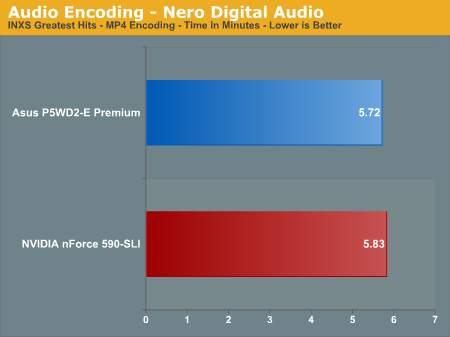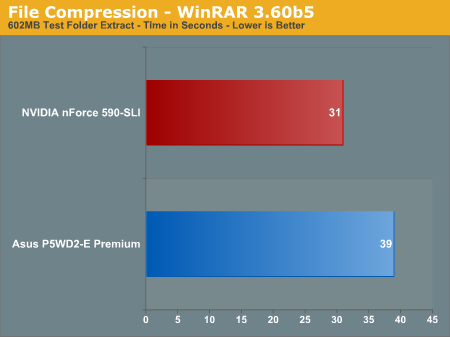nForce 590 SLI Intel Edition: NVIDIA prepares an Intel 975X Killer
by Gary Key on June 27, 2006 6:15 AM EST- Posted in
- CPUs
Audio Encoding Performance
Our last audio test (and we are sure our ears and those of the neighbors were ecstatic about this), utilizes Nero Digital Audio to extract all 16 tracks and convert them into an MP4 format. We changed the default quality settings to transcoder-ultra, variable bit rate, encoder quality to high, and the AAC profile to LC. We were determined to give both our platforms a workout with this test.

These results have us scratching our heads as this test is equally demanding of the CPU and storage system, but the Intel 975X chipset completes the task up to 7 seconds quicker in each of our benchmark runs. Even the creation of an iPEAK trace file generated the same results during playback. We did note that the hard drive access was consistent on the Intel system while the NVIDIA board had several throughput peaks but just as many lows that resulted in the slower times. The difference is only 2%, but it's still interesting given that the NVIDIA board seems to perform slightly better in some of the other storage-related testing.
File Compression Performance
In order to save space on our hard drives and ensure we had another CPU crunching utility, we will be reporting our file compression results with the latest beta version of WinRAR that fully supports multi-treaded operations and should be of particular interest for those users with dual core or multi-processor systems. Our series of file compression tests utilize WinRAR 3.60b5 to compress our test folder that contains 444 files, ten subfolders, and 602MB worth of data. All default settings are utilized in WinRAR along with our hard drive being defragmented before each test.


The results speak for themselves with the NVIDIA based system outperforming the Intel system in the decompression tasks by a significant margin (26% faster), but we see the Intel system finishing in front in the grueling compression test (3% faster). Once again, we ran the test several times with the same results. We noticed on our iPEAK test that the disk activity of the NVIDIA board varied somewhat, but the decompression tests are generally more limited by storage system performance whereas the compression tests stress the memory subsystem more. The board could use some additional BIOS tuning for disk activities and the memory subsystem, and hopefully NVIDIA can manage to get more storage subsystem results like the WinRAR decompression benchmark. For now, the NVIDIA board does well in the short and sequential audio tests and file decompression, while it trails slightly in file compression and certain other audio tests.
Our last audio test (and we are sure our ears and those of the neighbors were ecstatic about this), utilizes Nero Digital Audio to extract all 16 tracks and convert them into an MP4 format. We changed the default quality settings to transcoder-ultra, variable bit rate, encoder quality to high, and the AAC profile to LC. We were determined to give both our platforms a workout with this test.

These results have us scratching our heads as this test is equally demanding of the CPU and storage system, but the Intel 975X chipset completes the task up to 7 seconds quicker in each of our benchmark runs. Even the creation of an iPEAK trace file generated the same results during playback. We did note that the hard drive access was consistent on the Intel system while the NVIDIA board had several throughput peaks but just as many lows that resulted in the slower times. The difference is only 2%, but it's still interesting given that the NVIDIA board seems to perform slightly better in some of the other storage-related testing.
File Compression Performance
In order to save space on our hard drives and ensure we had another CPU crunching utility, we will be reporting our file compression results with the latest beta version of WinRAR that fully supports multi-treaded operations and should be of particular interest for those users with dual core or multi-processor systems. Our series of file compression tests utilize WinRAR 3.60b5 to compress our test folder that contains 444 files, ten subfolders, and 602MB worth of data. All default settings are utilized in WinRAR along with our hard drive being defragmented before each test.


The results speak for themselves with the NVIDIA based system outperforming the Intel system in the decompression tasks by a significant margin (26% faster), but we see the Intel system finishing in front in the grueling compression test (3% faster). Once again, we ran the test several times with the same results. We noticed on our iPEAK test that the disk activity of the NVIDIA board varied somewhat, but the decompression tests are generally more limited by storage system performance whereas the compression tests stress the memory subsystem more. The board could use some additional BIOS tuning for disk activities and the memory subsystem, and hopefully NVIDIA can manage to get more storage subsystem results like the WinRAR decompression benchmark. For now, the NVIDIA board does well in the short and sequential audio tests and file decompression, while it trails slightly in file compression and certain other audio tests.










37 Comments
View All Comments
rallyhard - Friday, June 30, 2006 - link
I, too, would like to see some RAID benchmarks for the motherboards when they're reviewed. Maybe even just reviewing the performance of a particular HD/RAID controller once, when it is tested on the first motherboard that you come across with that controller, would suffice.(I don't know how much HD/RAID performance varies from mobo to mobo with the same controller)
I certainly wouldn't have bought my Gigabyte 7n400 Pro2 socket A board if I had known the performance penalty of running RAID on the ITE 8212 chip as opposed to running a single drive on the nForce2 controller. The IDE raid functionality was the only reason I chose that board over the Abit NF7. The only way I found out that my horrible performance was truly and solely due to that 8212 chip is by doing a search on that chip and reading forums.
Incredibly, some manufacturers are still using that same chip for their IDE.
Anyway, I'm sure IDE performace is now a moot point for most, but yeah, RAID performance testing on future mobo (or controller) testing would, to me, be a useful addition to your excellent reviews.
Keep up the good work!
Crassus - Tuesday, June 27, 2006 - link
Perhaps someone can enlighten me on this: How much of an real-world impact in contemporary games does SLI 8/8 lanes compared to 16/16 lanes have? I remember reading an article about this issue back in the days when PCI-E was introduced, but I haven't really heared anything about it since. So, did anyone do a test on this?DigitalFreak - Tuesday, June 27, 2006 - link
I think X-Bit did a test not so long ago, and concluded there is still no advantage of 16x16 over 8x8.Avalon - Tuesday, June 27, 2006 - link
Sheesh, this is a pre-production board.CrystalBay - Tuesday, June 27, 2006 - link
Sheesh, look at the size NB fan.nullpointerus - Tuesday, June 27, 2006 - link
Just below the big features table on the basic features page, there's a sentence which should read:"Intel didn't officially want their 975X chipset to support 533FSB processors, but [a few] motherboard manufacturers disagreed on this point[, and] the end result is that 975X motherboards are able to run Celeron D chips."
At least I think that's how it's supposed to read.
nullpointerus - Tuesday, June 27, 2006 - link
Further down:"Considering the layout of expansion slots on ATX/BTX motherboards, [this] would be our ideal configuration, and the remaining expansion slots can be filled out with either X1/X2 PCI-E or regular PCI connectors."
...and also:
"There really doesn't see[m to be] much point in including X1 physical slots, particularly on enthusiast level hardware, and ATI at least has already recommended that motherboard manufacturers begin including more X16 physical connectors."
Gary Key - Tuesday, June 27, 2006 - link
Jarred and I got our wires crossed during the edit process this morning, it was easy to do at 5:30am after being up for about 26 hours with this board and another "new" chipset preview that should be finished shortly. ;-> However, no excuse on my part for not noticing the missing/incorrect text. I have corrected our mistakes and sincerely hope the changes are acceptable. Thank you for the comments and taking time to write. :)PedroDaGr8 - Tuesday, June 27, 2006 - link
I noticed on the compression/decompression page, page 7 I think. Both of the graphs are labeled File compresision - WinRAR 3.60b5 602MB Test Folder - Time In Minutes - Lower Is Better. Shouldn't one of them (the bottom one I guess) be labeled File Decompression, or atleast since you mention it first in the article shouldn't it be on top. That led to a quick bout of confusion for me, hey maybe it is just the painpills (I blew out my knee last week, tore my ACL and LCL (Lateral Colateral Ligament) with possible damage to my PCL and MCL as well. Nothing like playing cricket for the first time and injuring yourself.JarredWalton - Tuesday, June 27, 2006 - link
I added a word to the subtitle now. Basically, File Compression is the benchmark category, followed by the benchmark application. The subtitle is for extra information about the particular test. Hopefully that makes sense - I can't say my brain is entirely functional at this hour of the morning. :)